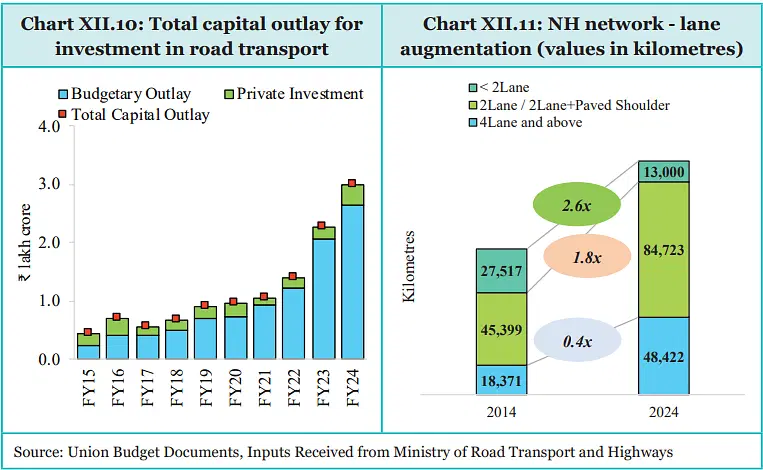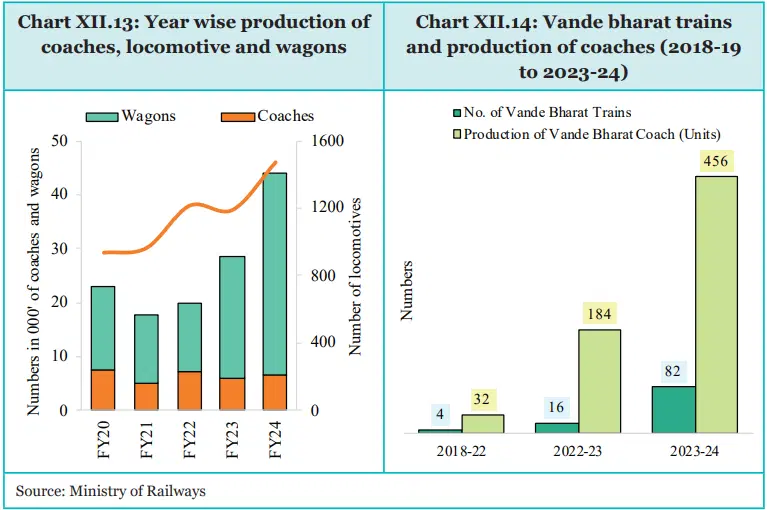The Economic Survey 2023-24 highlighted several significant developments and progress in India’s infrastructure growth story. Here are 12 developments related to key infrastructure sectors noted in the survey.
One, 1.6 times increase in national highways development from 2014-2024. The Bharatmala Pariyojana has significantly expanded the national highway network. The average pace of highway construction has tripled from 11.7 kilometres (km) per day in fiscal year 2014 (FY14) to 34 km per day by FY24.
Two, government and private sector capital investment rose from 0.4 per cent of the gross domestic product (GDP) in FY15 to about 1 per cent (around Rs 3.01 lakh crore) in FY24. The sector attracted its highest-ever private investment in FY24.

Three, under Pradhan Mantri Gram Sadak Yojana (PMGSY), 829,409 km of road length have been sanctioned, with 763,308 km completed by June 2024, at an expenditure of Rs 3.23 lakh crore (including the state share).
Four, six multimodal logistics parks (MMLPs) have been awarded until FY24, with investments totaling Rs 2,505 crore. Seven more MMLPs are planned for FY25. By integrating various modes of transportation, MMLPs can shorten the time needed to move goods between locations, thereby improving the country’s logistics sector. Additionally, 11 industrial corridor projects are being developed in phases as part of the national industrial corridor programme.
Five, India remains among the largest growing aviation markets. Twelve greenfield airports have been operationalised out of the 21 approved. In FY24, new terminal buildings at 21 airports were opened, supporting increased passenger handling capacity.
Six, since the commencement of the UDAN Regional Connectivity Scheme (RCS) seven years ago, 1,390 routes have been awarded to various airlines, with 579 routes connecting 85 unserved and underserved airports now operational.
Seven, the government has a capex plan of over Rs 26,000 crore for FY20 to FY25. The Airports Authority of India (AAI) has achieved around Rs 23,000 crore till FY24. Additionally, public-private partnerships (PPP) and other airport operators have invested around Rs 49,000 crore, totalling Rs 72,000 crore in airport sector capital expenditure over the last five years.
Eight, railway capex increased by 77 per cent over the past five years. Multiple big-ticket railway projects are also making progress:
- The Amrit Bharat Station Redevelopment Scheme, to upgrade 1,324 stations nationwide
- The Mumbai-Ahmedabad High Speed Rail project reached 41.7 per cent completion, with Rs 59,291 crore spent by 31 March 2024
- By the end of FY24, 96.1 per cent of the total Dedicated Freight Corridor (DFC) route length was completed

Nine, under the Mission 100 per cent Electrification Programme, the Indian Railways’ electrified network extended to 63,456 km (96.4 per cent). Electrification progressed at a rate of about 5,594 route km per year over the past five years (2019-24).
Ten, India’s rank in World Bank Logistics Performance Index for International Shipments improved to 22nd in 2023 from 44th in 2014. Ports, shipping, and waterways sector capital expenditure grew by 27 per cent from FY23 to FY24.
Eleven, the ‘Harit Sagar’ Green Port guidelines, launched in May 2023, have led to four major ports generating more renewable energy than they consume.
Twelve, the Indo-Bangladesh Protocol (IBP) route, developed at an estimated cost of Rs 305.84 crore, provides alternate connectivity for all North Eastern states from Guwahati and Jogighopa to Kolkata and Haldia ports. The cargo handled via the IBP route has significantly increased due to initiatives taken in the last nine years.


